实例介绍
【实例截图】
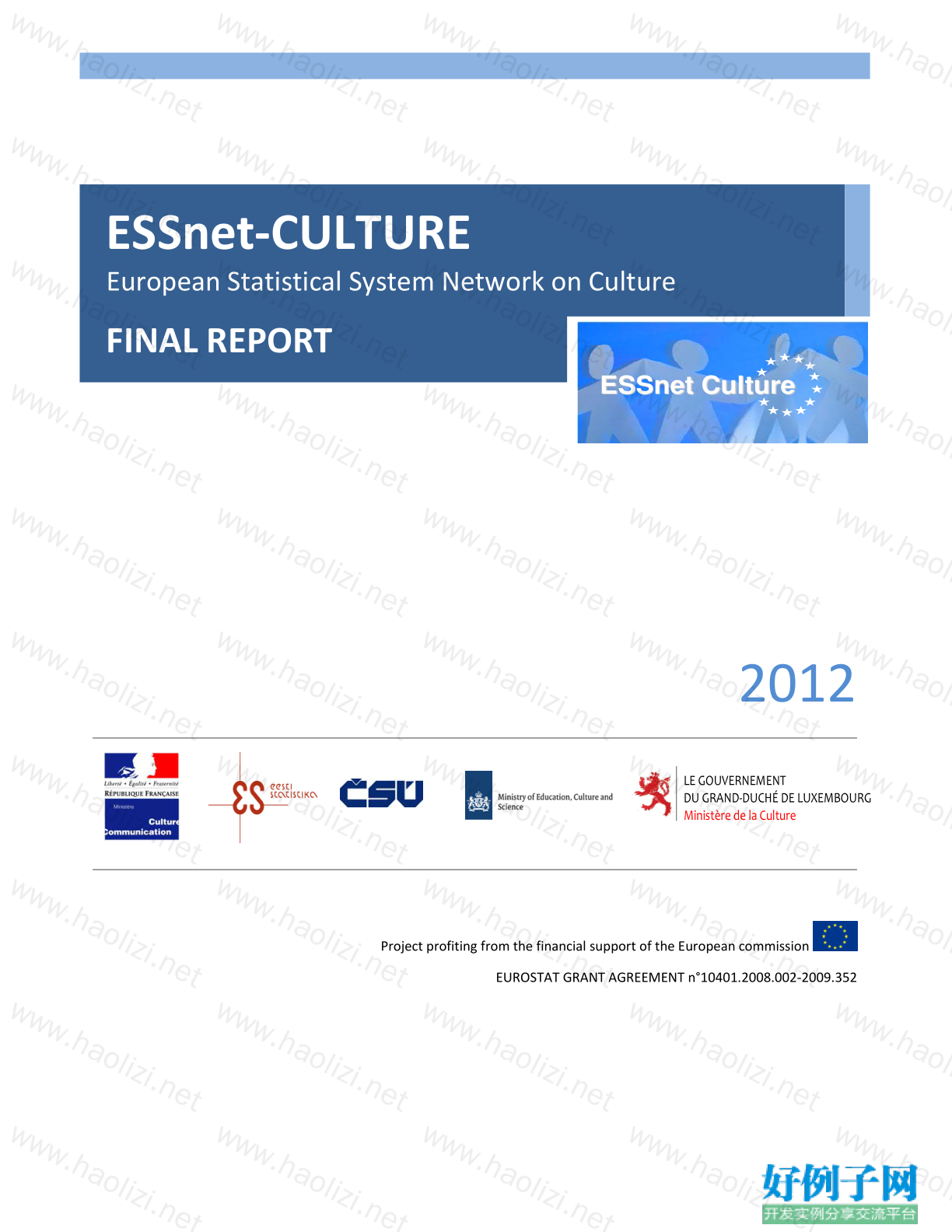

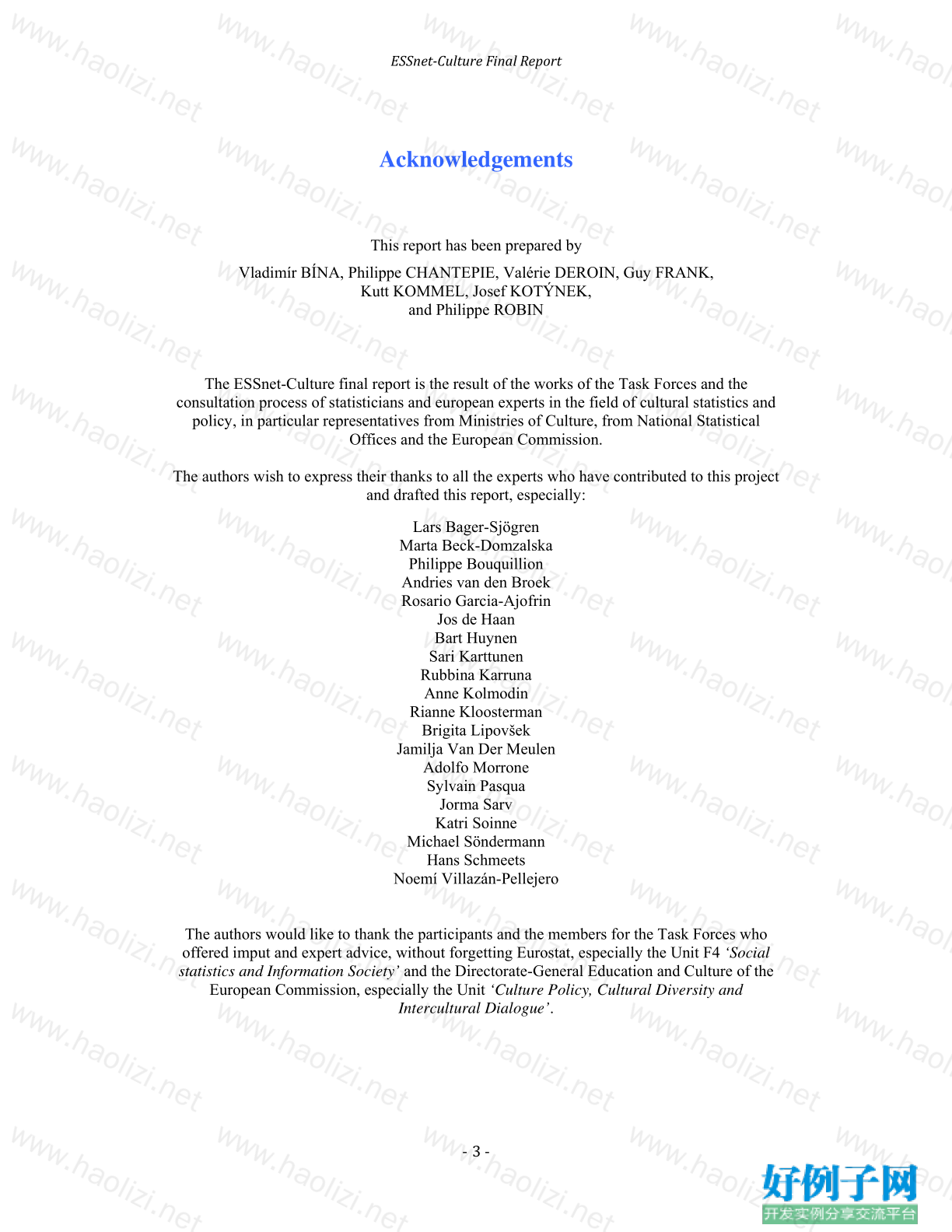
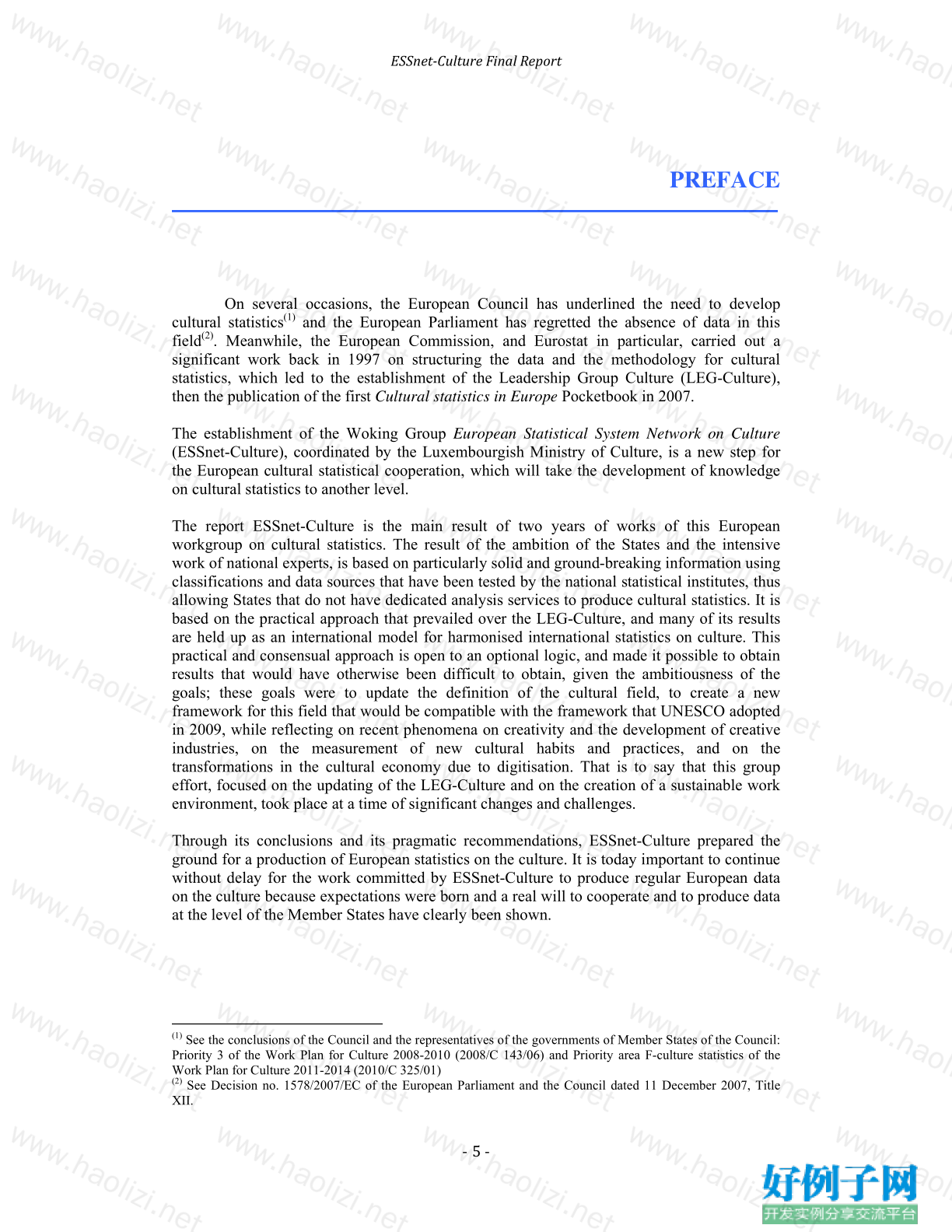
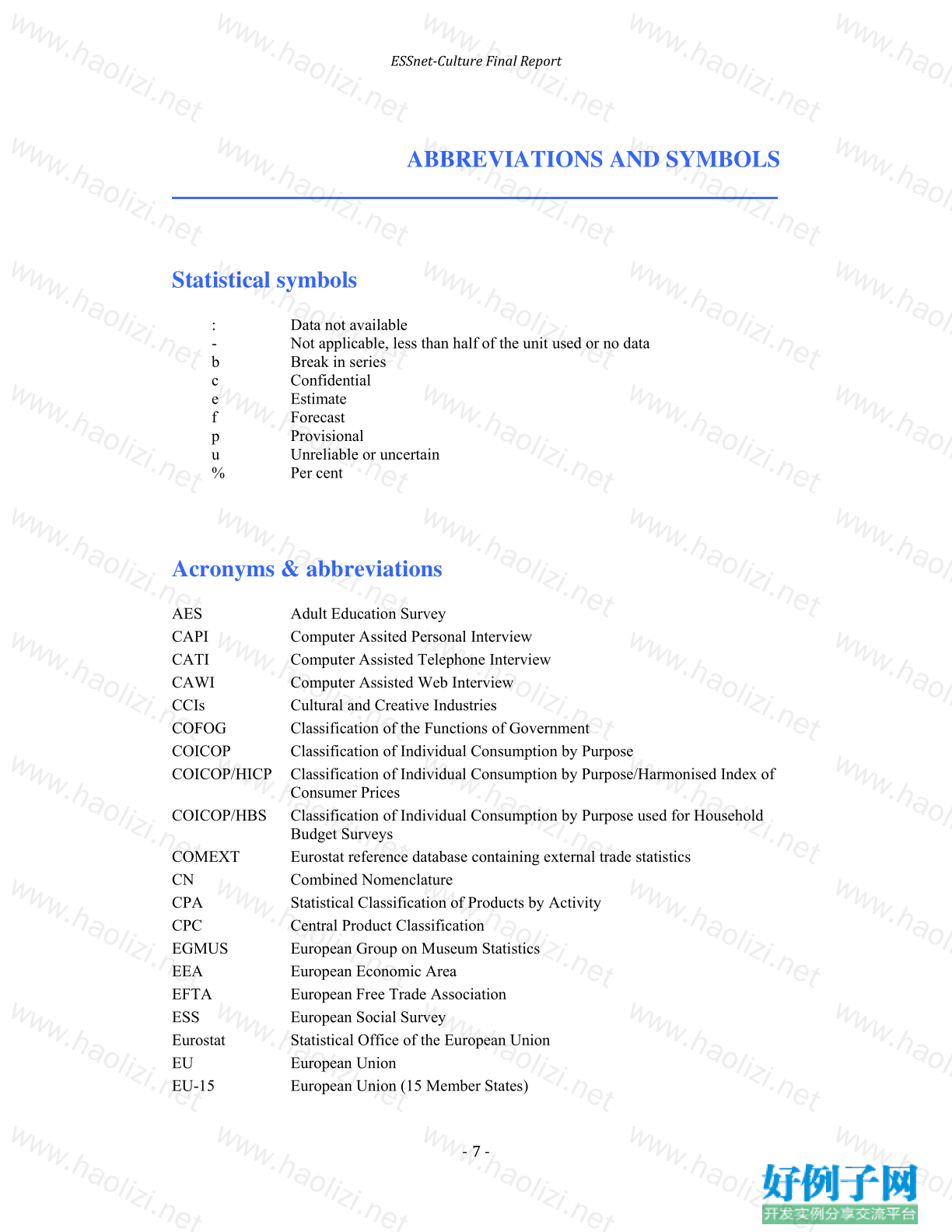
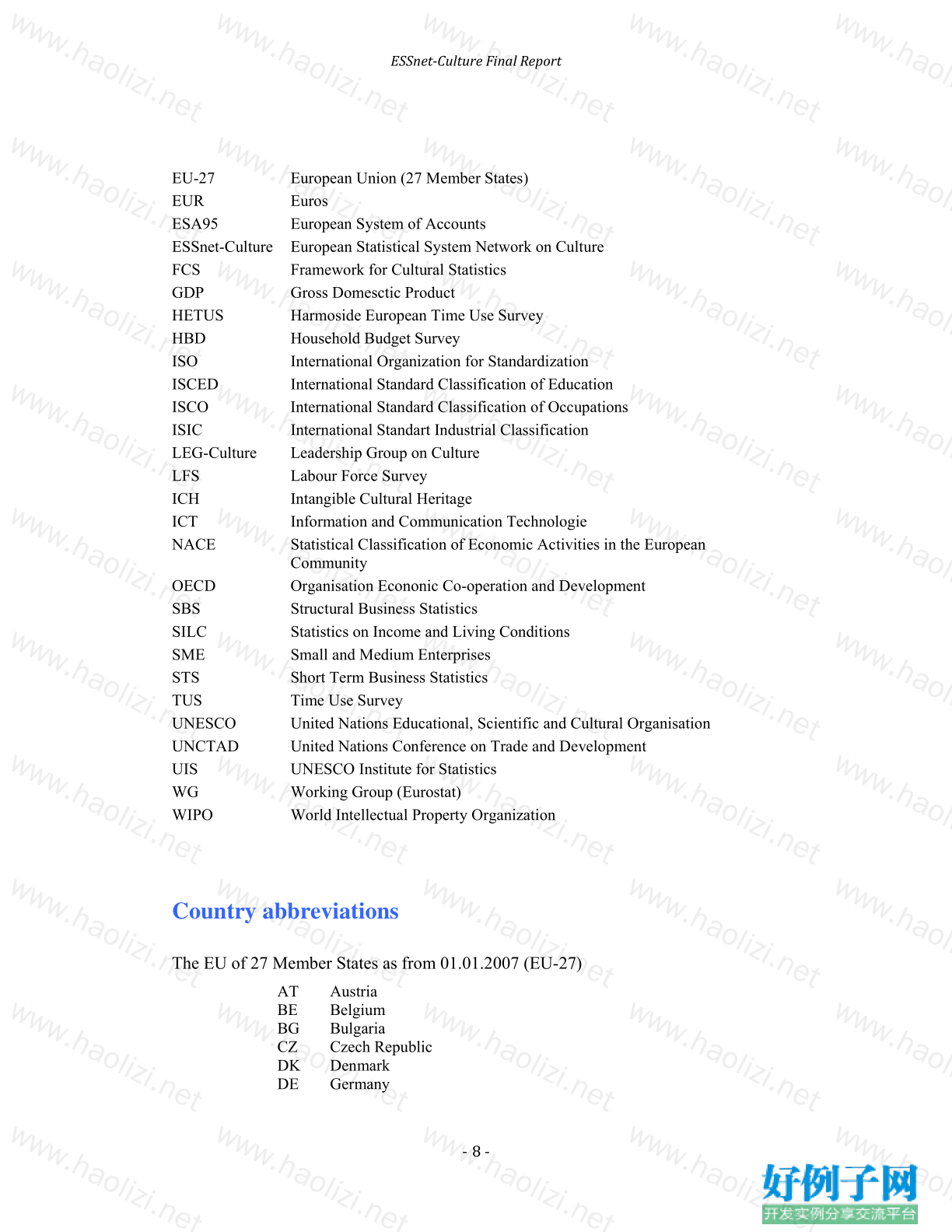
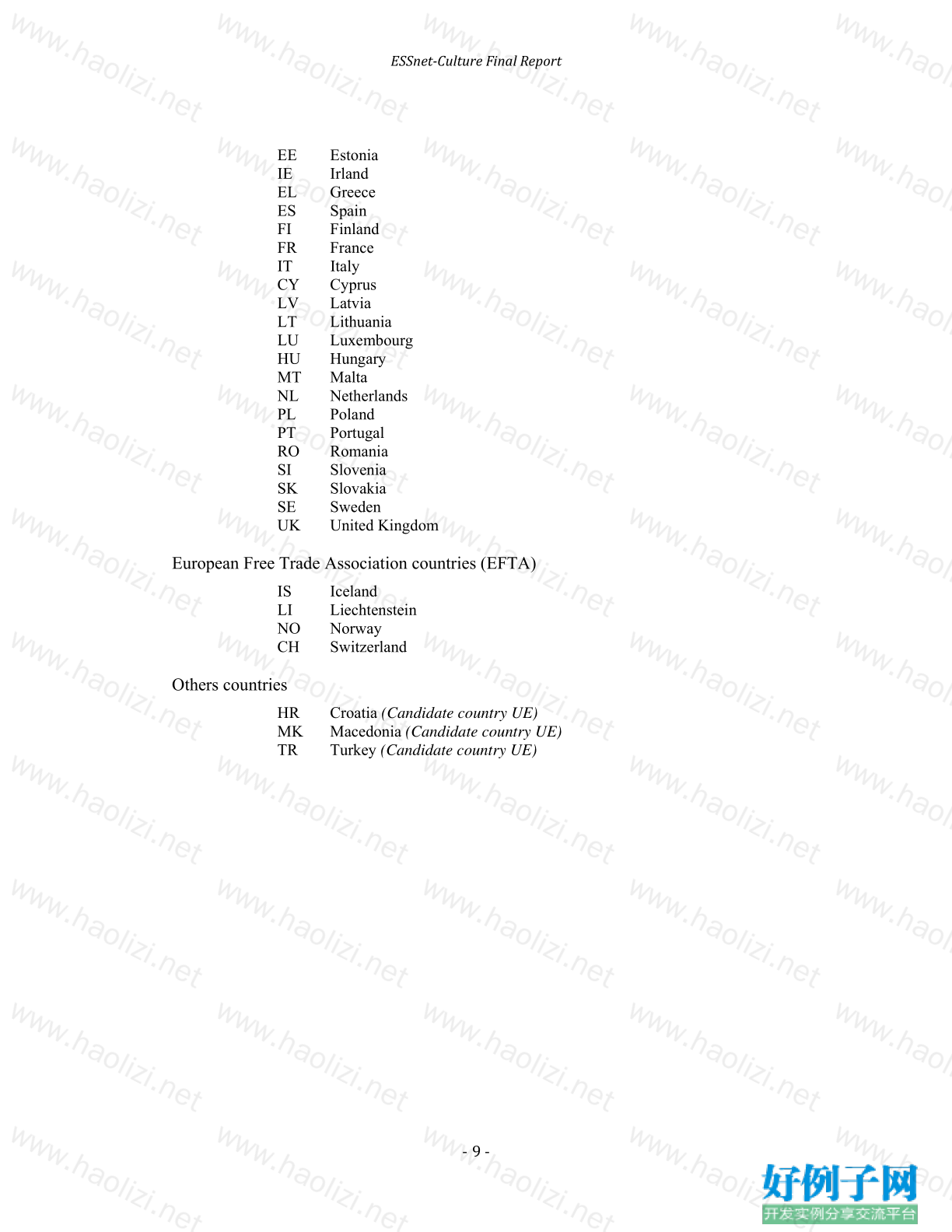
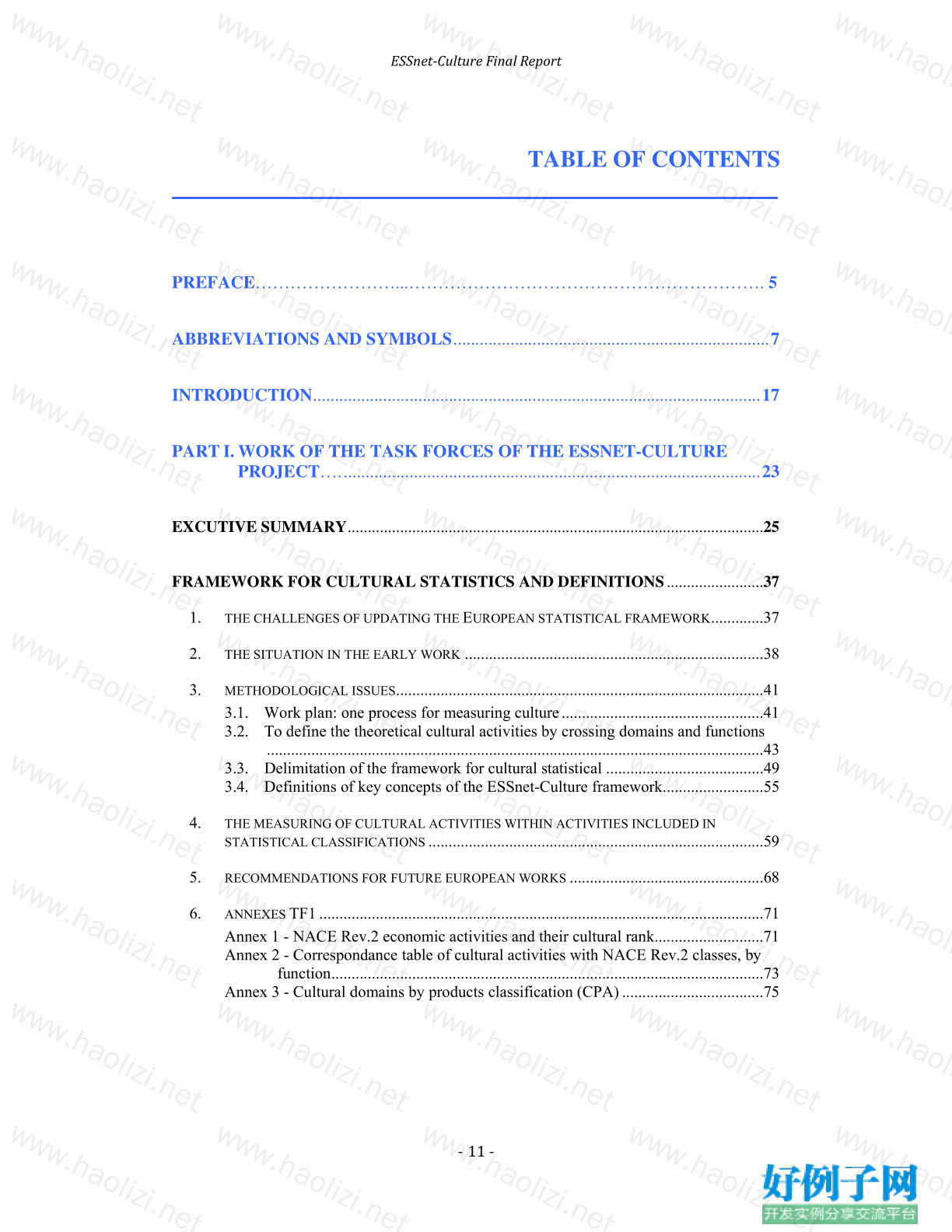
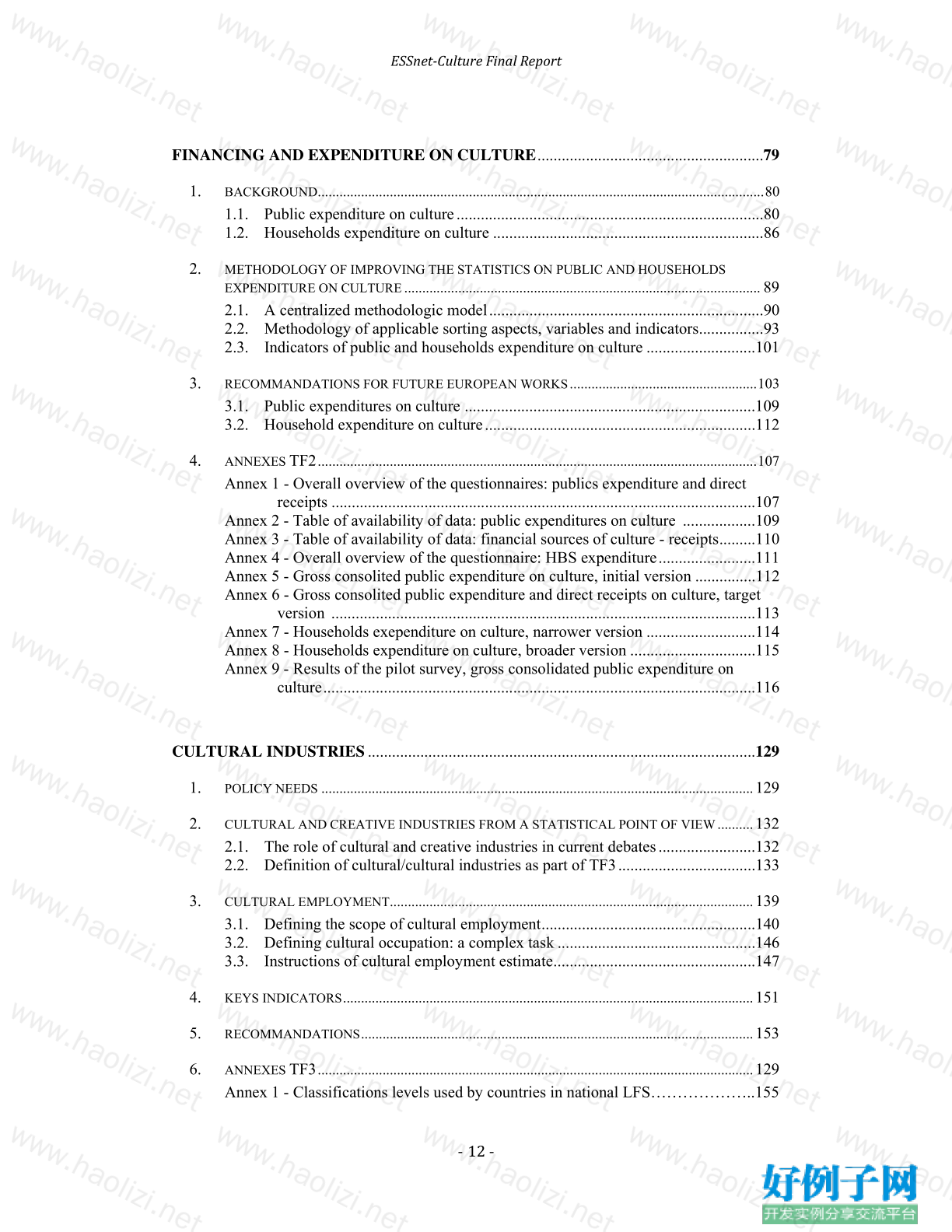
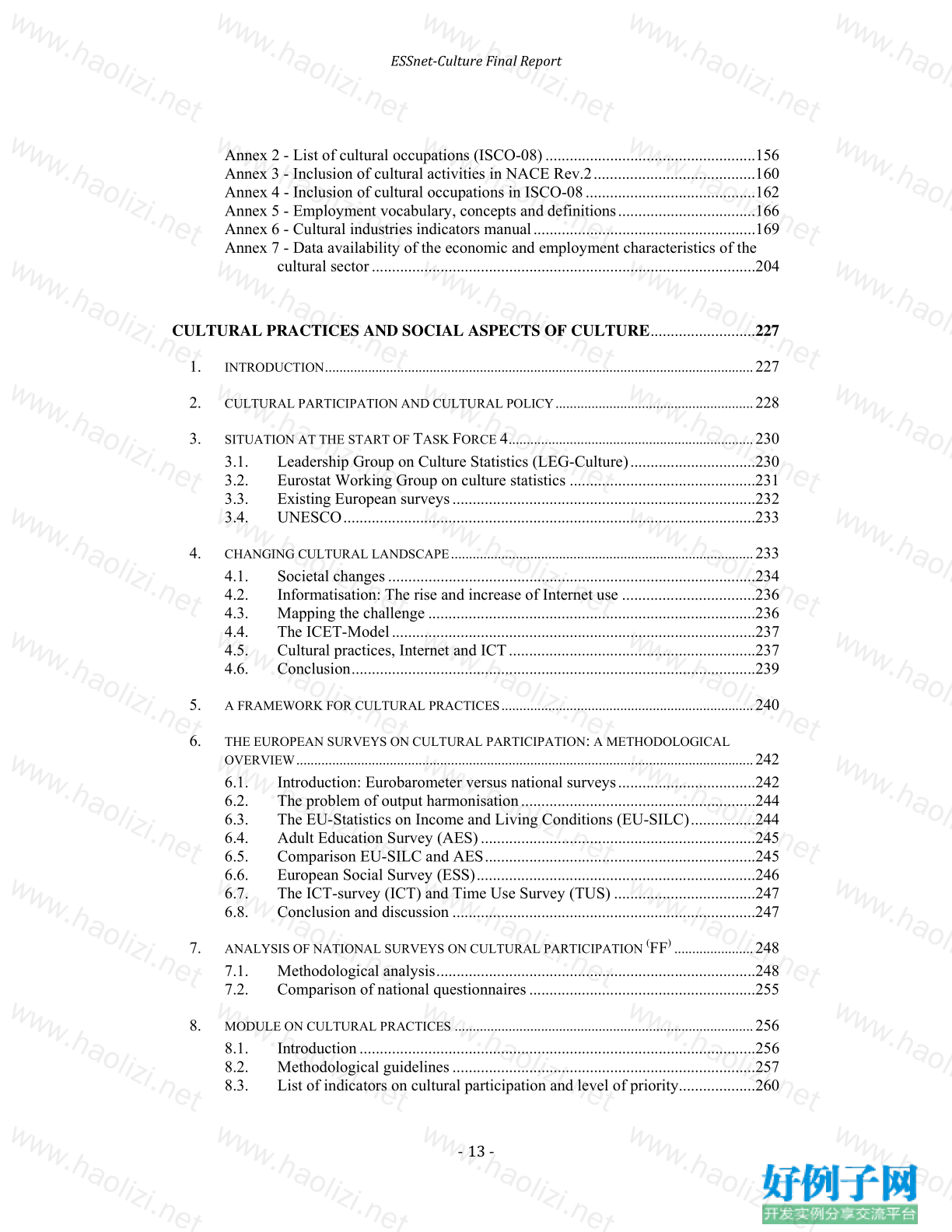
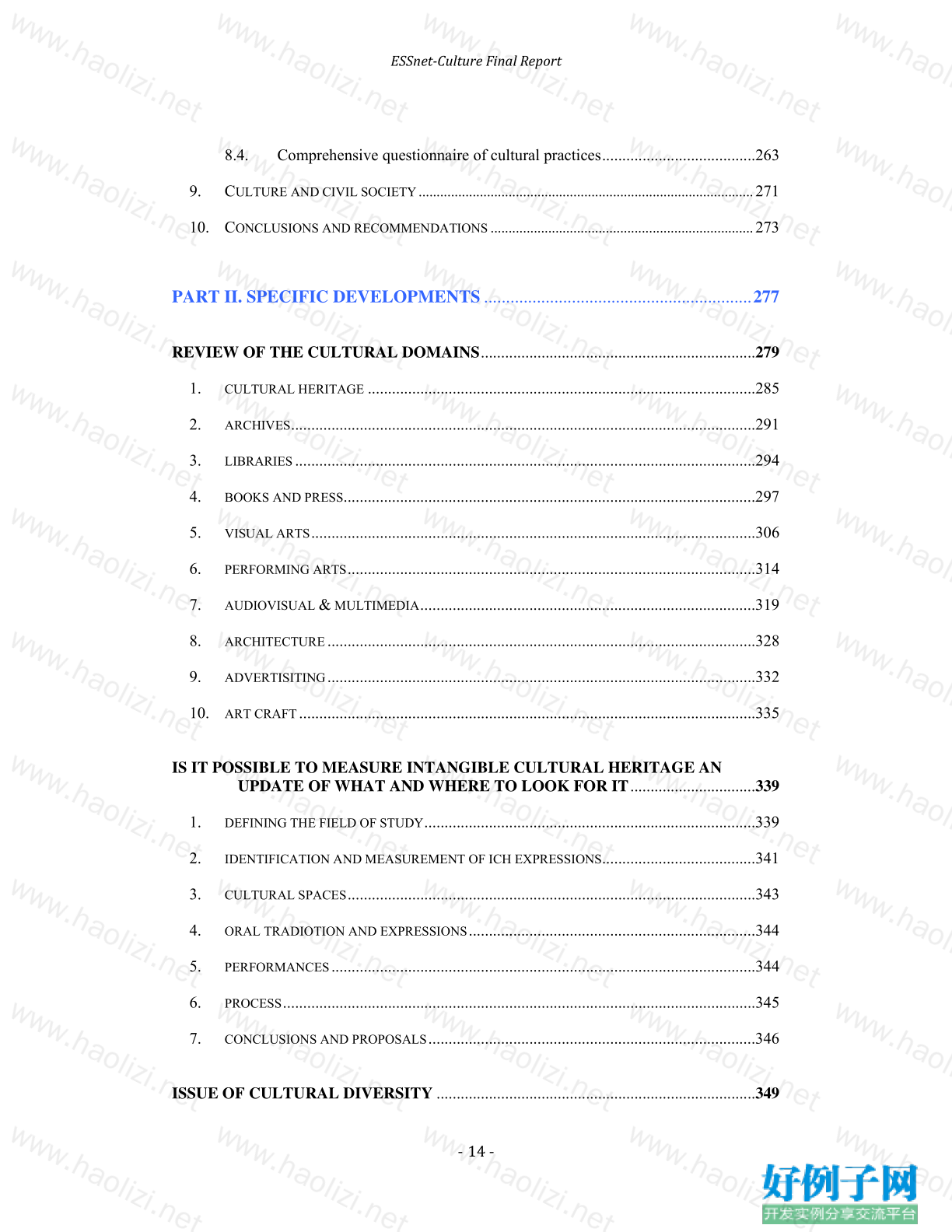
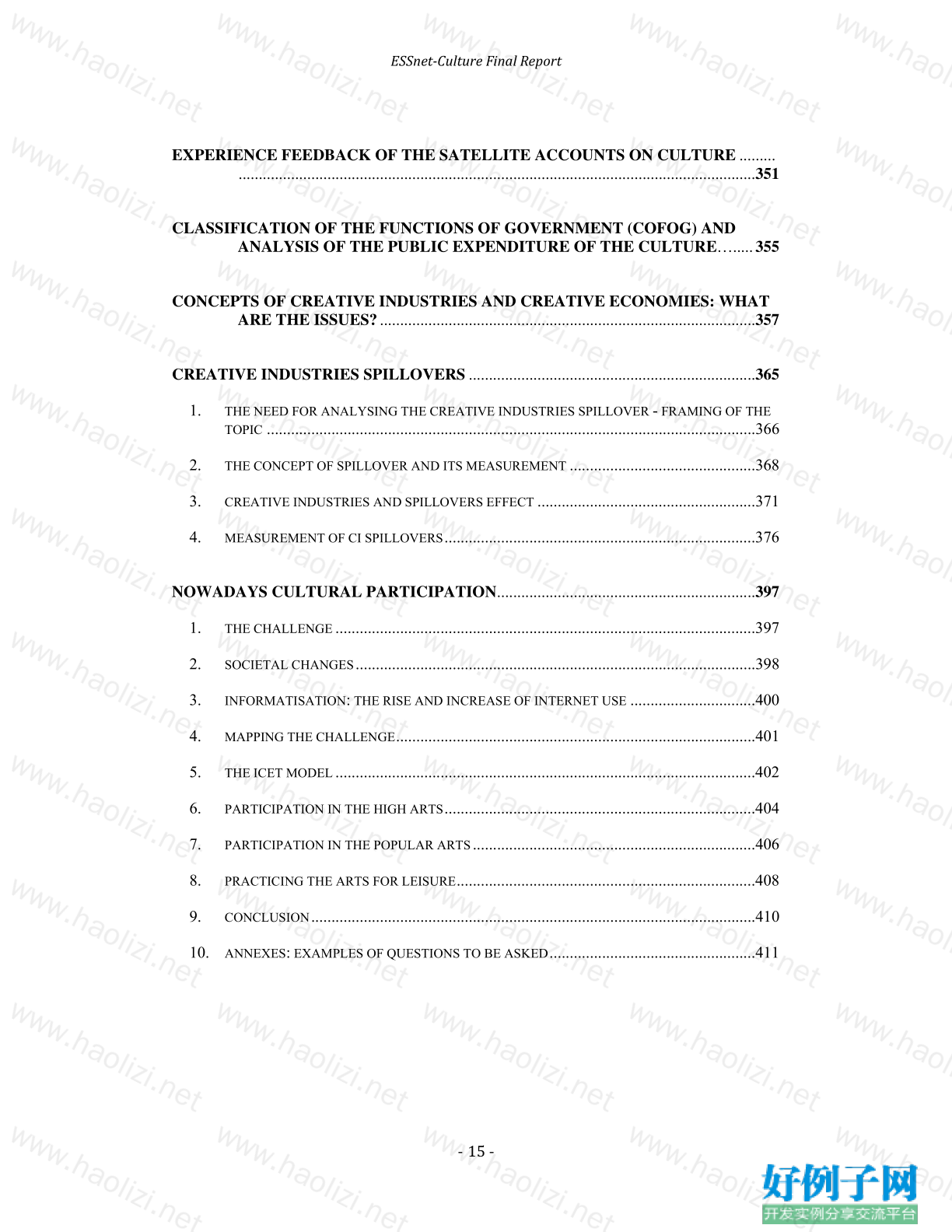
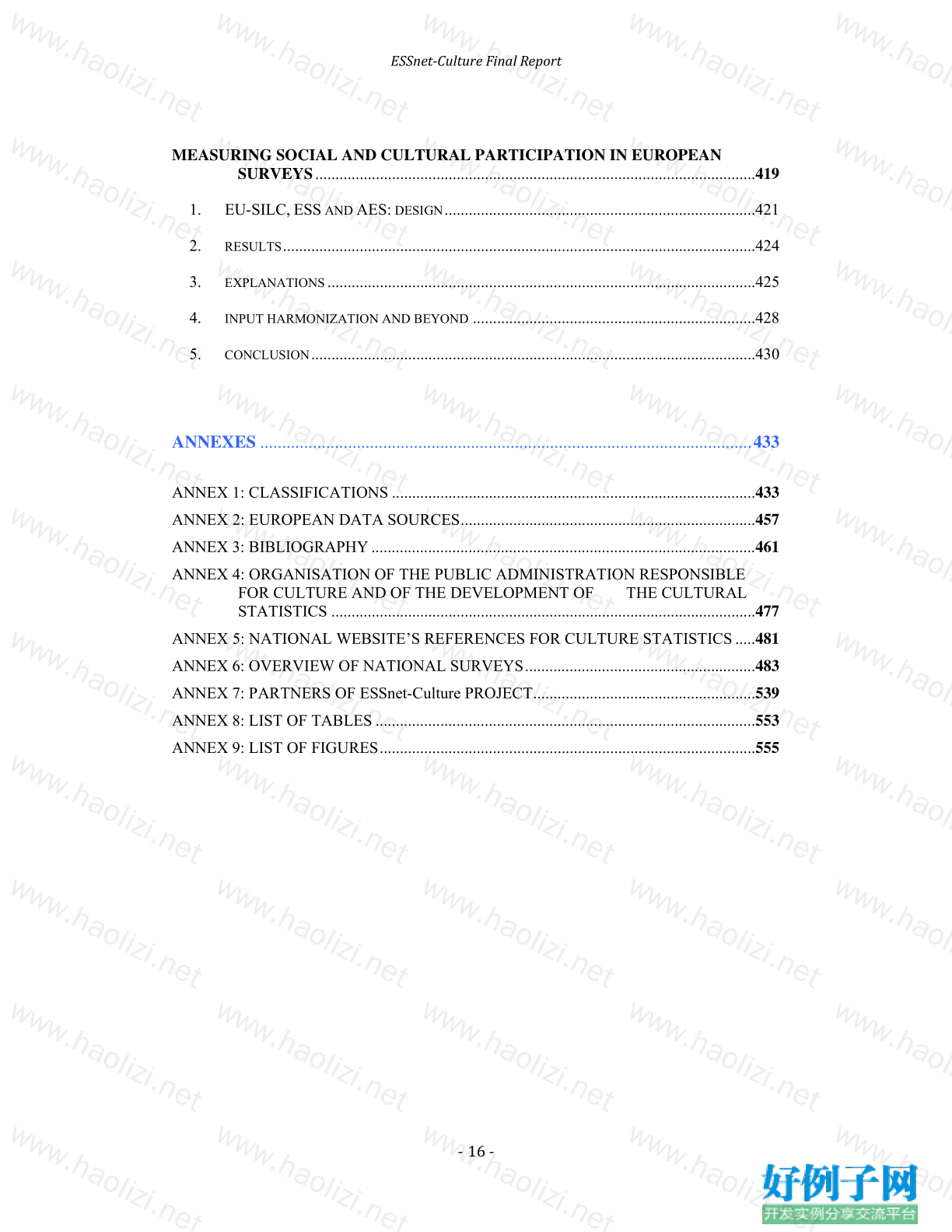
【核心代码】
ABBREVIATIONS AND SYMBOLS
Statistical symbols
: Data not available
- Not applicable, less than half of the unit used or no data
b Break in series
c Confidential
e Estimate
f Forecast
p Provisional
u Unreliable or uncertain
% Per cent
Acronyms & abbreviations
AES Adult Education Survey
CAPI Computer Assited Personal Interview
CATI Computer Assisted Telephone Interview
CAWI Computer Assisted Web Interview
CCIs Cultural and Creative Industries
COFOG Classification of the Functions of Government
COICOP Classification of Individual Consumption by Purpose
COICOP/HICP Classification of Individual Consumption by Purpose/Harmonised Index of
Consumer Prices
COICOP/HBS Classification of Individual Consumption by Purpose used for Household
Budget Surveys
COMEXT Eurostat reference database containing external trade statistics
CN Combined Nomenclature
CPA Statistical Classification of Products by Activity
CPC Central Product Classification
EGMUS European Group on Museum Statistics
EEA European Economic Area
EFTA European Free Trade Association
ESS European Social Survey
Eurostat Statistical Office of the European Union
EU European Union
EU-15 European Union (15 Member States)
ESSnet‐Culture Final Report
- 8 -
EU-27 European Union (27 Member States)
EUR Euros
ESA95 European System of Accounts
ESSnet-Culture European Statistical System Network on Culture
FCS Framework for Cultural Statistics
GDP Gross Domesctic Product
HETUS Harmoside European Time Use Survey
HBD Household Budget Survey
ISO International Organization for Standardization
ISCED International Standard Classification of Education
ISCO International Standard Classification of Occupations
ISIC International Standart Industrial Classification
LEG-Culture Leadership Group on Culture
LFS Labour Force Survey
ICH Intangible Cultural Heritage
ICT Information and Communication Technologie
NACE Statistical Classification of Economic Activities in the European
Community
OECD Organisation Econonic Co-operation and Development
SBS Structural Business Statistics
SILC Statistics on Income and Living Conditions
SME Small and Medium Enterprises
STS Short Term Business Statistics
TUS Time Use Survey
UNESCO United Nations Educational, Scientific and Cultural Organisation
UNCTAD United Nations Conference on Trade and Development
UIS UNESCO Institute for Statistics
WG Working Group (Eurostat)
WIPO World Intellectual Property Organization
Country abbreviations
The EU of 27 Member States as from 01.01.2007 (EU-27)
AT Austria
BE Belgium
BG Bulgaria
CZ Czech Republic
DK Denmark
DE Germany
ESSnet‐Culture Final Report
- 9 -
EE Estonia
IE Irland
EL Greece
ES Spain
FI Finland
FR France
IT Italy
CY Cyprus
LV Latvia
LT Lithuania
LU Luxembourg
HU Hungary
MT Malta
NL Netherlands
PL Poland
PT Portugal
RO Romania
SI Slovenia
SK Slovakia
SE Sweden
UK United Kingdom
European Free Trade Association countries (EFTA)
IS Iceland
LI Liechtenstein
NO Norway
CH Switzerland
Others countries
HR Croatia (Candidate country UE)
MK Macedonia (Candidate country UE)
TR Turkey (Candidate country UE)
ESSnet‐Culture Final Report
- 11 -
TABLE OF CONTENTS
PREFACE……………………...……………………………………………………. 5
ABBREVIATIONS AND SYMBOLS ........................................................................ 7
INTRODUCTION ...................................................................................................... 17
PART I. WORK OF THE TASK FORCES OF THE ESSNET-CULTURE
PROJECT…. ............................................................................................... 23
EXCUTIVE SUMMARY .......................................................................................................25
FRAMEWORK FOR CULTURAL STATISTICS AND DEFINITIONS ........................37
1. THE CHALLENGES OF UPDATING THE E UROPEAN STATISTICAL FRAMEWORK .............37
2. THE SITUATION IN THE EARLY WORK ..........................................................................38
3. METHODOLOGICAL ISSUES ...........................................................................................41
3.1. Work plan: one process for measuring culture ..................................................41
3.2. To define the theoretical cultural activities by crossing domains and functions
...........................................................................................................................43
3.3. Delimitation of the framework for cultural statistical .......................................49
3.4. Definitions of key concepts of the ESSnet-Culture framework.........................55
4. THE MEASURING OF CULTURAL ACTIVITIES WITHIN ACTIVITIES INCLUDED IN
STATISTICAL CLASSIFICATIONS ...................................................................................59
5. RECOMMENDATIONS FOR FUTURE EUROPEAN WORKS ................................................68
6. ANNEXES TF1 ..............................................................................................................71
Annex 1 - NACE Rev.2 economic activities and their cultural rank ...........................71
Annex 2 - Correspondance table of cultural activities with NACE Rev.2 classes, by
function ...........................................................................................................73
Annex 3 - Cultural domains by products classification (CPA) ...................................75
ESSnet‐Culture Final Report
- 12 -
FINANCING AND EXPENDITURE ON CULTURE ........................................................79
1. BACKGROUND ............................................................................................................................ 80
1.1. Public expenditure on culture ............................................................................80
1.2. Households expenditure on culture ...................................................................86
2. METHODOLOGY OF IMPROVING THE STATISTICS ON PUBLIC AND HOUSEHOLDS
EXPENDITURE ON CULTURE ................................................................................................... 89
2.1. A centralized methodologic model ....................................................................90
2.2. Methodology of applicable sorting aspects, variables and indicators ................93
2.3. Indicators of public and households expenditure on culture ...........................101
3. RECOMMANDATIONS FOR FUTURE EUROPEAN WORKS .................................................... 103
3.1. Public expenditures on culture ........................................................................109
3.2. Household expenditure on culture ...................................................................112
4. ANNEXES TF2 .......................................................................................................................... 107
Annex 1 - Overall overview of the questionnaires: publics expenditure and direct
receipts .........................................................................................................107
Annex 2 - Table of availability of data: public expenditures on culture ..................109
Annex 3 - Table of availability of data: financial sources of culture - receipts .........110
Annex 4 - Overall overview of the questionnaire: HBS expenditure ........................111
Annex 5 - Gross consolited public expenditure on culture, initial version ...............112
Annex 6 - Gross consolited public expenditure and direct receipts on culture, target
version .........................................................................................................113
Annex 7 - Households exependiture on culture, narrower version ...........................114
Annex 8 - Households expenditure on culture, broader version ...............................115
Annex 9 - Results of the pilot survey, gross consolidated public expenditure on
culture ...........................................................................................................116
CULTURAL INDUSTRIES ................................................................................................129
1. POLICY NEEDS ........................................................................................................................ 129
2. CULTURAL AND CREATIVE INDUSTRIES FROM A STATISTICAL POINT OF VIEW .......... 132
2.1. The role of cultural and creative industries in current debates ........................132
2.2. Definition of cultural/cultural industries as part of TF3 ..................................133
3. CULTURAL EMPLOYMENT ..................................................................................................... 139
3.1. Defining the scope of cultural employment .....................................................140
3.2. Defining cultural occupation: a complex task .................................................146
3.3. Instructions of cultural employment estimate ..................................................147
4. KEYS INDICATORS .................................................................................................................. 151
5. RECOMMANDATIONS ............................................................................................................. 153
6. ANNEXES TF3 ......................................................................................................................... 129
Annex 1 - Classifications levels used by countries in national LFS………………..155
ESSnet‐Culture Final Report
- 13 -
Annex 2 - List of cultural occupations (ISCO-08) ....................................................156
Annex 3 - Inclusion of cultural activities in NACE Rev.2 ........................................160
Annex 4 - Inclusion of cultural occupations in ISCO-08 ..........................................162
Annex 5 - Employment vocabulary, concepts and definitions ..................................166
Annex 6 - Cultural industries indicators manual .......................................................169
Annex 7 - Data availability of the economic and employment characteristics of the
cultural sector ...............................................................................................204
CULTURAL PRACTICES AND SOCIAL ASPECTS OF CULTURE ..........................227
1. INTRODUCTION ....................................................................................................................... 227
2. CULTURAL PARTICIPATION AND CULTURAL POLICY ....................................................... 228
3. SITUATION AT THE START OF T ASK F ORCE 4 .................................................................... 230
3.1. Leadership Group on Culture Statistics (LEG-Culture) ...............................230
3.2. Eurostat Working Group on culture statistics ..............................................231
3.3. Existing European surveys ...........................................................................232
3.4. UNESCO ......................................................................................................233
4. CHANGING CULTURAL LANDSCAPE .................................................................................... 233
4.1. Societal changes ...........................................................................................234
4.2. Informatisation: The rise and increase of Internet use .................................236
4.3. Mapping the challenge .................................................................................236
4.4. The ICET-Model ..........................................................................................237
4.5. Cultural practices, Internet and ICT .............................................................237
4.6. Conclusion ....................................................................................................239
5. A FRAMEWORK FOR CULTURAL PRACTICES ...................................................................... 240
6. THE EUROPEAN SURVEYS ON CULTURAL PARTICIPATION : A METHODOLOGICAL
OVERVIEW ............................................................................................................................... 242
6.1. Introduction: Eurobarometer versus national surveys ..................................242
6.2. The problem of output harmonisation ..........................................................244
6.3. The EU-Statistics on Income and Living Conditions (EU-SILC) ................244
6.4. Adult Education Survey (AES) ....................................................................245
6.5. Comparison EU-SILC and AES ...................................................................245
6.6. European Social Survey (ESS) .....................................................................246
6.7. The ICT-survey (ICT) and Time Use Survey (TUS) ...................................247
6.8. Conclusion and discussion ...........................................................................247
7. ANALYSIS OF NATIONAL SURVEYS ON CULTURAL PARTICIPATION ( FF ) ...................... 248
7.1. Methodological analysis ...............................................................................248
7.2. Comparison of national questionnaires ........................................................255
8. MODULE ON CULTURAL PRACTICES ................................................................................... 256
8.1. Introduction ..................................................................................................256
8.2. Methodological guidelines ...........................................................................257
8.3. List of indicators on cultural participation and level of priority ...................260
ESSnet‐Culture Final Report
- 14 -
8.4. Comprehensive questionnaire of cultural practices ......................................263
9. C ULTURE AND CIVIL SOCIETY ............................................................................................. 271
10. C ONCLUSIONS AND RECOMMENDATIONS ......................................................................... 273
PART II. SPECIFIC DEVELOPMENTS ............................................................. 277
REVIEW OF THE CULTURAL DOMAINS ....................................................................279
1. CULTURAL HERITAGE ................................................................................................285
2. ARCHIVES ...................................................................................................................291
3. LIBRARIES ..................................................................................................................294
4. BOOKS AND PRESS ......................................................................................................297
5. VISUAL ARTS ..............................................................................................................306
6. PERFORMING ARTS .....................................................................................................314
7. AUDIOVISUAL & MULTIMEDIA ...................................................................................319
8. ARCHITECTURE ..........................................................................................................328
9. ADVERTISITING ..........................................................................................................332
10. ART CRAFT .................................................................................................................335
IS IT POSSIBLE TO MEASURE INTANGIBLE CULTURAL HERITAGE AN
UPDATE OF WHAT AND WHERE TO LOOK FOR IT ...............................339
1. DEFINING THE FIELD OF STUDY ..................................................................................339
2. IDENTIFICATION AND MEASUREMENT OF ICH EXPRESSIONS ......................................341
3. CULTURAL SPACES .....................................................................................................343
4. ORAL TRADIOTION AND EXPRESSIONS .......................................................................344
5. PERFORMANCES .........................................................................................................344
6. PROCESS .....................................................................................................................345
7. CONCLUSIONS AND PROPOSALS .................................................................................346
ISSUE OF CULTURAL DIVERSITY ...............................................................................349
ESSnet‐Culture Final Report
- 15 -
EXPERIENCE FEEDBACK OF THE SATELLITE ACCOUNTS ON CULTURE .........
................................................................................................................................351
CLASSIFICATION OF THE FUNCTIONS OF GOVERNMENT (COFOG) AND
ANALYSIS OF THE PUBLIC EXPENDITURE OF THE CULTURE…..... 355
CONCEPTS OF CREATIVE INDUSTRIES AND CREATIVE ECONOMIES: WHAT
ARE THE ISSUES? .............................................................................................357
CREATIVE INDUSTRIES SPILLOVERS .......................................................................365
1. THE NEED FOR ANALYSING THE CREATIVE INDUSTRIES SPILLOVER - FRAMING OF THE
TOPIC .........................................................................................................................366
2. THE CONCEPT OF SPILLOVER AND ITS MEASUREMENT ..............................................368
3. CREATIVE INDUSTRIES AND SPILLOVERS EFFECT ......................................................371
4. MEASUREMENT OF CI SPILLOVERS .............................................................................376
NOWADAYS CULTURAL PARTICIPATION ................................................................397
1. THE CHALLENGE ........................................................................................................397
2. SOCIETAL CHANGES ...................................................................................................398
3. INFORMATISATION : THE RISE AND INCREASE OF INTERNET USE ...............................400
4. MAPPING THE CHALLENGE .........................................................................................401
5. THE ICET MODEL ........................................................................................................402
6. PARTICIPATION IN THE HIGH ARTS .............................................................................404
7. PARTICIPATION IN THE POPULAR ARTS ......................................................................406
8. PRACTICING THE ARTS FOR LEISURE ..........................................................................408
9. CONCLUSION ..............................................................................................................410
10. ANNEXES : EXAMPLES OF QUESTIONS TO BE ASKED ...................................................411
ESSnet‐Culture Final Report
- 16 -
MEASURING SOCIAL AND CULTURAL PARTICIPATION IN EUROPEAN
SURVEYS .............................................................................................................419
1. EU-SILC, ESS AND AES: DESIGN .............................................................................421
2. RESULTS .....................................................................................................................424
3. EXPLANATIONS ..........................................................................................................425
4. INPUT HARMONIZATION AND BEYOND ......................................................................428
5. CONCLUSION ..............................................................................................................430
ANNEXES ................................................................................................................ 433
ANNEX 1: CLASSIFICATIONS ..........................................................................................433
ANNEX 2: EUROPEAN DATA SOURCES .........................................................................457
ANNEX 3: BIBLIOGRAPHY ...............................................................................................461
ANNEX 4: ORGANISATION OF THE PUBLIC ADMINISTRATION RESPONSIBLE
FOR CULTURE AND OF THE DEVELOPMENT OF THE CULTURAL
STATISTICS .........................................................................................................477
ANNEX 5: NATIONAL WEBSITE’S REFERENCES FOR CULTURE STATISTICS .....481
ANNEX 6: OVERVIEW OF NATIONAL SURVEYS .........................................................483
ANNEX 7: PARTNERS OF ESSnet-Culture PROJECT .......................................................539
ANNEX 8: LIST OF TABLES ..............................................................................................553
ANNEX 9: LIST OF FIGURES .............................................................................................555
小贴士
感谢您为本站写下的评论,您的评论对其它用户来说具有重要的参考价值,所以请认真填写。
- 类似“顶”、“沙发”之类没有营养的文字,对勤劳贡献的楼主来说是令人沮丧的反馈信息。
- 相信您也不想看到一排文字/表情墙,所以请不要反馈意义不大的重复字符,也请尽量不要纯表情的回复。
- 提问之前请再仔细看一遍楼主的说明,或许是您遗漏了。
- 请勿到处挖坑绊人、招贴广告。既占空间让人厌烦,又没人会搭理,于人于己都无利。
关于好例子网
本站旨在为广大IT学习爱好者提供一个非营利性互相学习交流分享平台。本站所有资源都可以被免费获取学习研究。本站资源来自网友分享,对搜索内容的合法性不具有预见性、识别性、控制性,仅供学习研究,请务必在下载后24小时内给予删除,不得用于其他任何用途,否则后果自负。基于互联网的特殊性,平台无法对用户传输的作品、信息、内容的权属或合法性、安全性、合规性、真实性、科学性、完整权、有效性等进行实质审查;无论平台是否已进行审查,用户均应自行承担因其传输的作品、信息、内容而可能或已经产生的侵权或权属纠纷等法律责任。本站所有资源不代表本站的观点或立场,基于网友分享,根据中国法律《信息网络传播权保护条例》第二十二与二十三条之规定,若资源存在侵权或相关问题请联系本站客服人员,点此联系我们。关于更多版权及免责申明参见 版权及免责申明



网友评论
我要评论